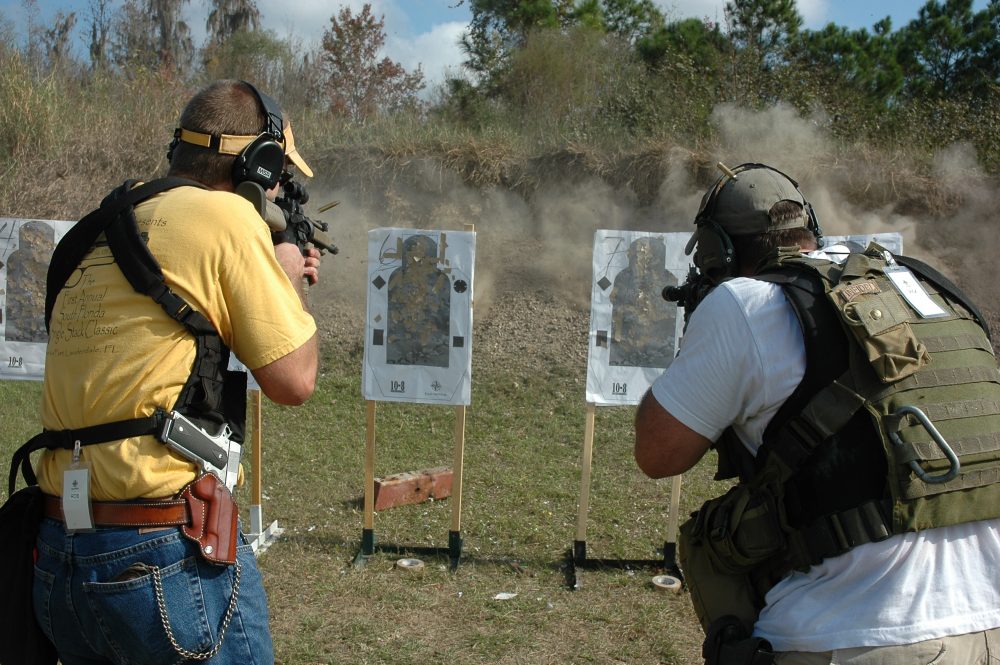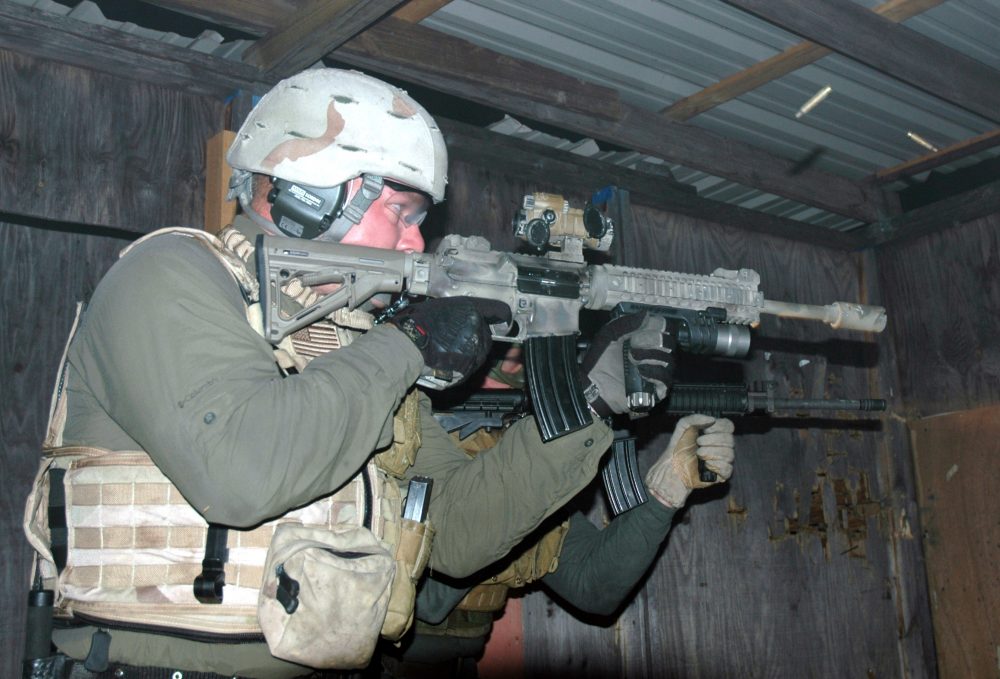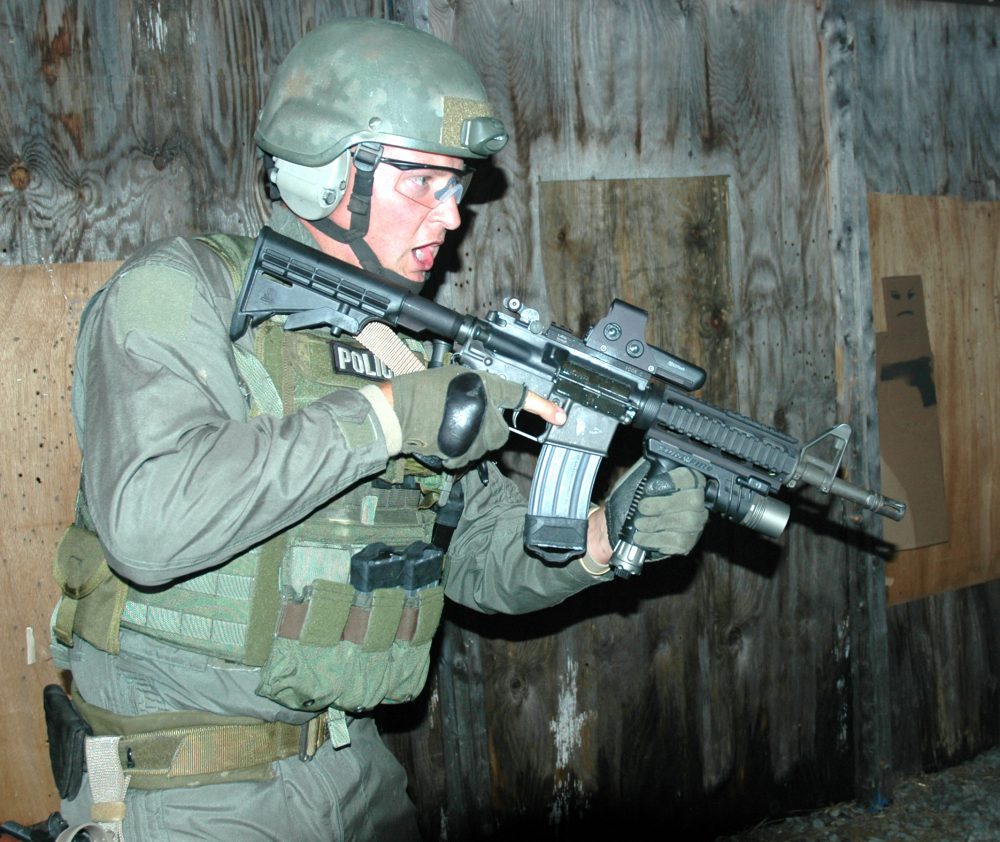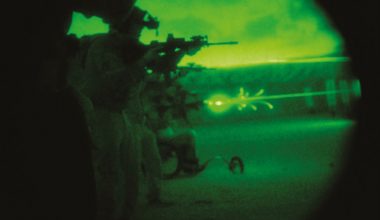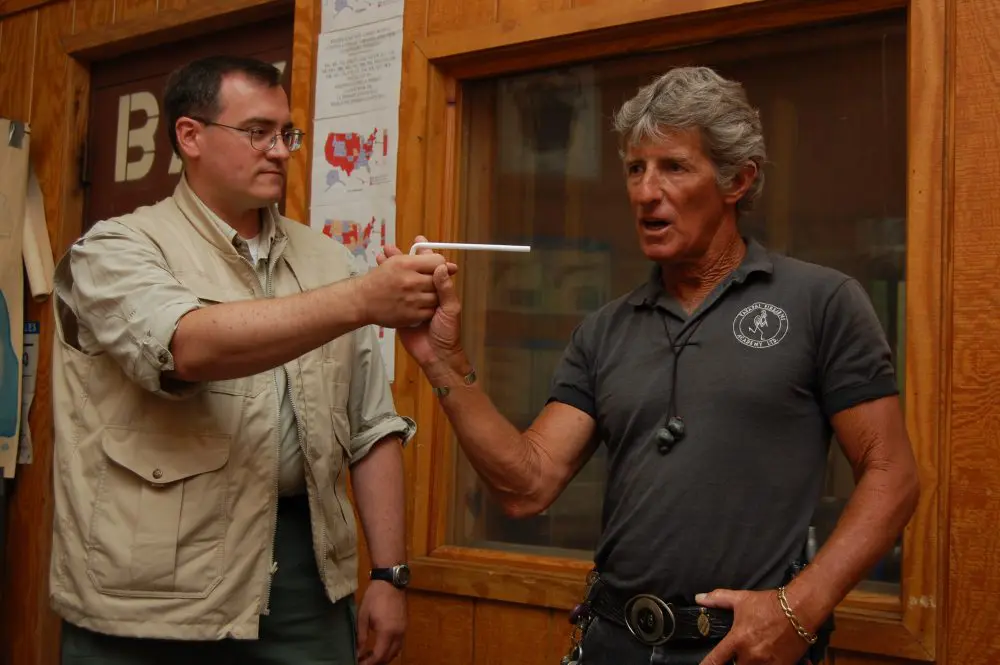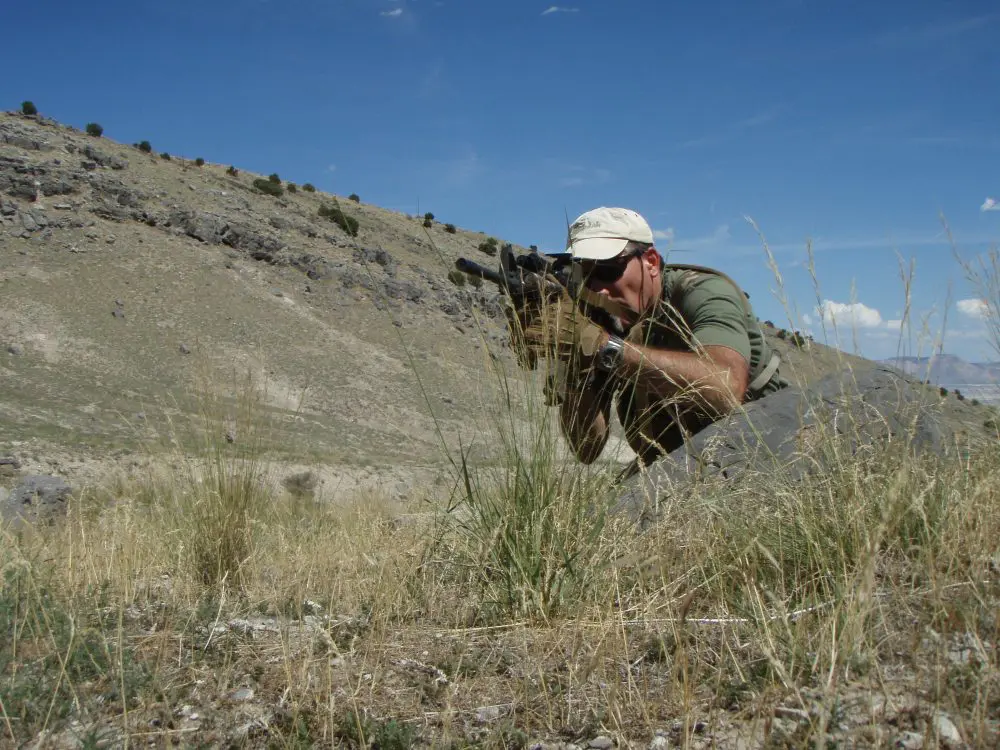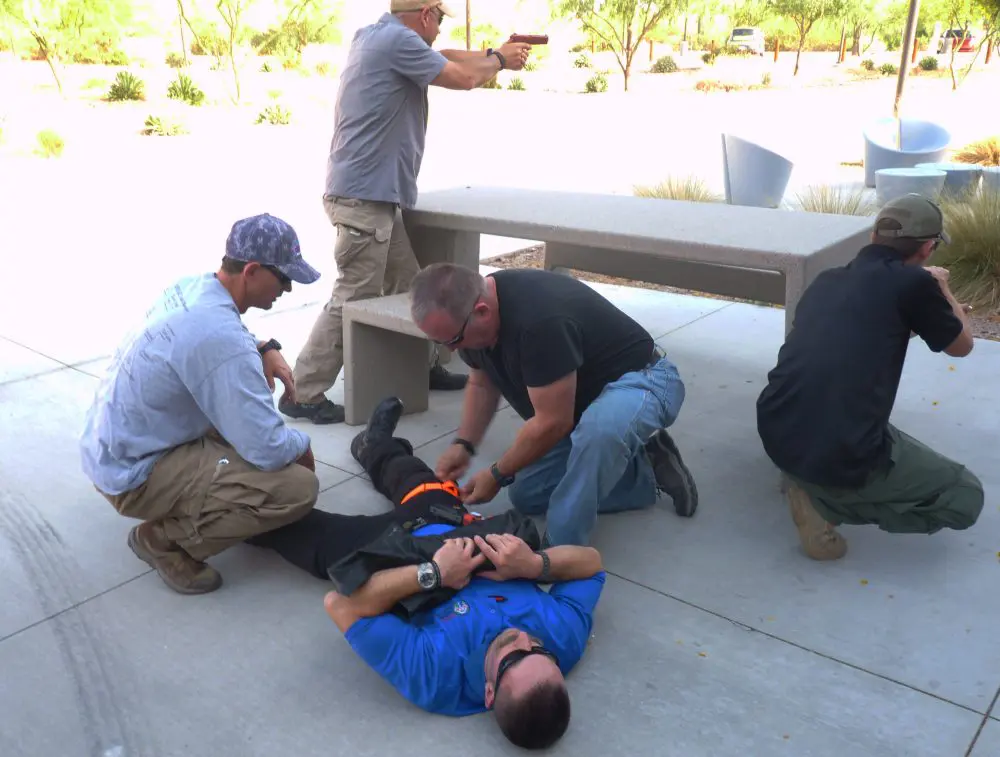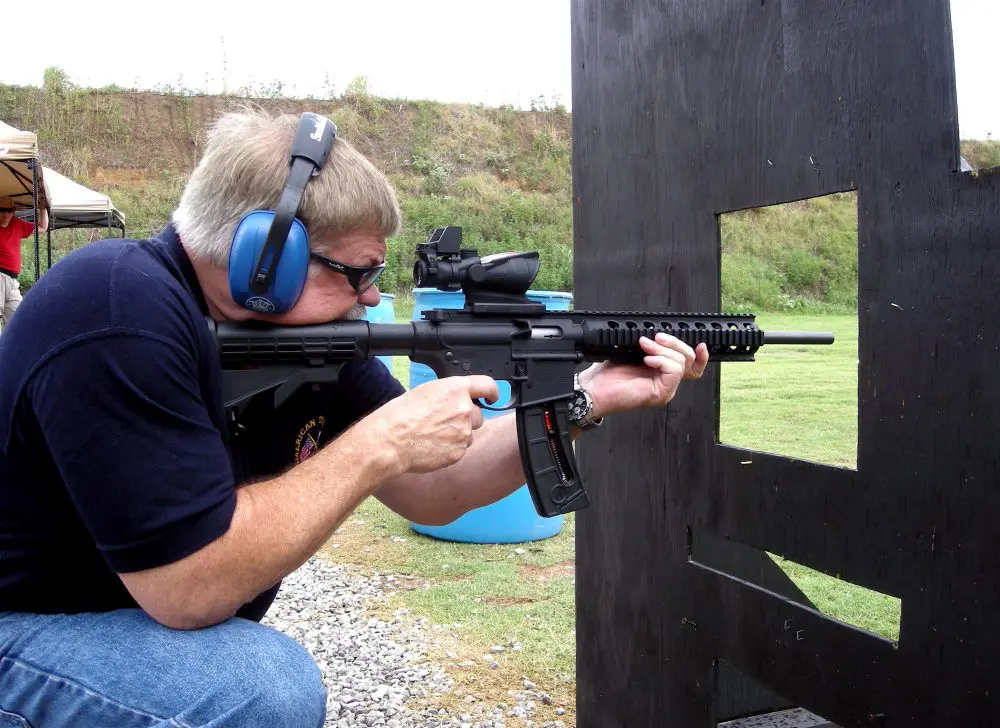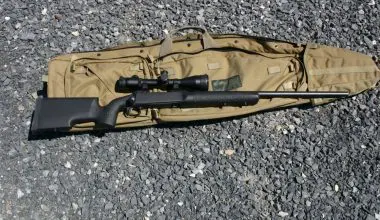Two shooters approach a situation based on their frame of reference. The shooter on the left (having just jumped from the pages of GQ Magazine) is a competitive shooter and a serious student. He wears a simple chest rig to allow him to carry sufficient ammunition to complete the required drills for this class. He wears his normal carry holster—a tactical holster is not necessary unless you are wearing armor/LBE. The visor, though better suited to a golf course, provides protection for his face. The shooter on the right works for a PMC and is getting back into the saddle after being WIA. He is wearing full armor, satisfying the “train as you fight” mantra. These two shooting buddies have different approaches for dissimilar mission requirements. The mission drives the gear train—not the other way around.
People attend training for a wide variety of reasons that may include a real world need or nothing more than an opportunity to have an Outward Bound-type trip.
Regardless of the rationale for attending, the end state is to build new skill sets. That skill building should include a combination of weapons manipulation, practical marksmanship, mindset and equipment issues.
Equipment is a physical thing, and is something that (unlike skill sets) can be purchased outright. This satisfies the urges of a great many people who, clearly influenced by the advertising world, believe that you can buy something that will grow hair, give you six-pack abs, make you irresistible to others, or in this case give you the ability to do HALO/HAHO, perform In Extremis hostage rescue and long-range target interdiction.
Reality doesn’t match fantasy, and the bottom line is that a great many people of all job descriptions show up at class with gear that is either insufficient or superfluous to the task. It is seldom that I have ever taught a class where the majority of the class didn’t reconfigure their gear at least once by Training Day 2 (TD2).
The major problem is that a great many people acquire gear prior to having a mission statement. Some of this is just good planning—we will need certain items pretty much across the board (magazine pouches are a prime example). Unfortunately for many, they will view an open space on a vest as a void yearning to be filled.
I once had a student at class who worked for a manufacturer in this business. He somehow promoted a full MC-CIRAS, and showed up for class with almost every pouch in that kit attached in some manner, shape or form to the vest. He looked to be the proverbial derriere clown, which fit his attitude and proficiency to a “T.” Without experience or knowledge, he now works for a larger firm with a more grandiose title. The Peter Principle is still with us.
These two Marines—training on their own nickel to enhance their skill sets—utilize equipment specific to their mission. Some believe that white lights have no use on a fighting gun, but the alternative—killing someone who doesn’t need killing, or being killed because you can’t acquire, see or engage a threat—makes them mandatory.
Table of Contents
THE MISSION DRIVES THE GEAR TRAIN—NOT THE OTHER WAY AROUND
Consider why you are attending the class and then consider what equipment you will need to support that task. This might include a vest, magazine pouches for primary and secondary weapons, a pistol holster and belt, a blow-out kit and possibly a utility pouch. Additional items may include a dump pouch, handheld white lights and other essential/good to have items.
The needs of someone executing a hostage rescue will be different from those of a rural deputy in East Cupcake, and his will be different from that L/Cpl Grunt who does the majority of the killing—and dying—in any war. And all of the above will have different requirements from private citizens who are taking a course for completely different reasons. There may be some items of commonality, but the number and placement of the oh-so-important “stuff” may not.
Figure out what you need to do, and get the equipment to support that mission. Avoid the urge to overload your body with unnecessary trash.
We have been preaching this for 15 years or so, but apparently a lot of people are intent on reinventing the wheel.
Some civilians will eschew load carriage, their thought process being that if they ever had to deploy a carbine for real they would have to do so without load carriage equipment, using instead trouser pockets and such. If you fit into this group, we can short circuit most of this article with a single sentence—make sure you have your trousers on when you get into a gunfight.
For the rest, consider the following as a guide.
ASSEMBLE THE KIT CORRECTLY
Generally speaking, most items will have an instruction sheet, which all “real” men will immediately ignore. Here is a tip, sports fans—read it. This may prevent you from extracting a magazine from a pouch and having the entire pouch separate from the vest because the MOLLE strap was not threaded properly. Whether by ignorance or laziness, you will not be able to properly insert that magazine into the intended weapon with the pouch attached. Different manufacturers may utilize different methods to accomplish the same goals. Make sure that you are familiar with your gear.
If equipment fails in training, you may only be “that guy.” Operationally, you may cease being an earthly oxygen consumer.
Want to re-consider tossing that instruction sheet now?
This very experienced SWAT cop understands the value of training and how the integration of Tactics, Techniques, Procedures and Equipment enhances mission accomplishment. While some equipment is similar to what some military units use, police operations are generally of shorter duration and in less hostile environments.
HAVE IMMEDIATE ACCESS TO CRITICAL ITEMS
In a recent class I watched a field grade officer attempt to draw his pistol. I say attempt because it was never completed. He placed a number of M4 magazines on his vest on his strong side—directly over his pistol holster. The magazine pouches were poorly placed for this purpose. Generally speaking, the magazines should be placed on the support side so that loading/reloads can be conducted with the support hand, while maintaining a firing grip with the strong side hand.
Certain missions may require more ammunition, and in this case magazines may have to be distributed across the entire vest. The world isn’t perfect, but you need to place your pouches wisely.
Set up an emergency reload pouch at your most accessible location. Use other locations for tac reloads/reloads with retention, but use the emergency reload pouch for speed reloads only. I keep my emergency reload pouch just off the centerline of my vest on the support side. Your mileage may vary.
DO NOT OCCLUDE ONE CRITICAL ITEM WITH ANOTHER
See above for an example, but it is not the only one. Some of the stacked magazine pouches (for example, M4 and pistol magazines combined) are designed so that access to one magazine may be blocked by another.
Critical items include, but are not limited to, magazines, medical items and other mission-essential gear. If you need it and can’t get to it, you are on the downhill slide to mission failure—or worse.
WHAT YOU NEED MUST FIT THE APPROPRIATE POUCHES
Don’t laugh. We have seen more than enough mag pouches that won’t accept the magazine they were made for; mislabeled mag pouches and other types of pouches that had design or manufacturing deficiencies so great that they were useless for original intent.
Test all of your pouches at home when you want to—not at a point in your life when you have to.
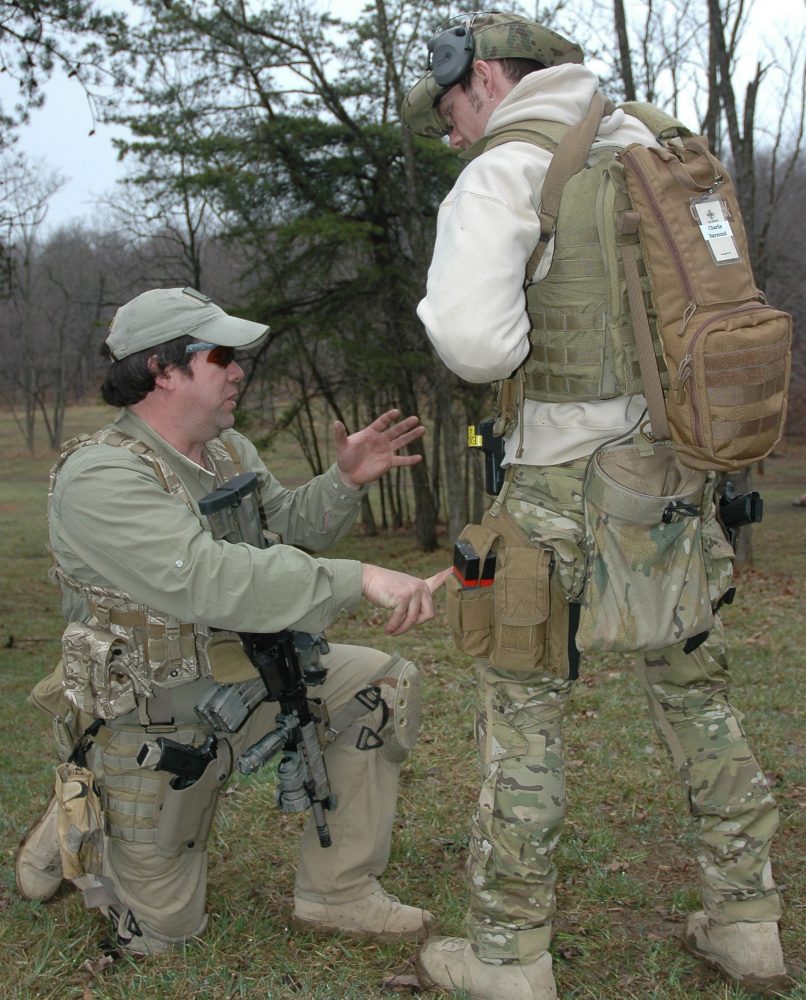
SUB LOADS (LEG RIGS) MAY NOT BE THE ANSWER
Sub loads are often an apparent and simple solution to carrying additional M4 mags. The problem with sub loads is that people have a tendency to overload them or purchase ones that accept a lot of magazines (think four magazines here). This may be fine when you are profiling in front of the mirror and racking up imaginary CDI points, but the reality of movement will quickly negate any usefulness.
This should be readily apparent, but many will gloss over certain deficiencies in order to justify the purchase of a sub load. An overloaded sub load will drag your war belt down, slide around the circumference of your leg and bang against your knee when moving. If you are concerned with that nylon tumor banging around your leg, you are probably not paying attention to the fight.
If you must use a sub load, consider limiting it to two M4 magazines.
THE TAC HOLSTER SHOULD NOT HANG DOWN AT YOUR KNEE
Tac holsters came about because body armor prevented access to pistols in standard belt holsters. The drop/tac holster lowered the pistol enough so that the draw stroke could be efficiently accomplished.
The downside was when people neglected to read the instructions that came with the holster (RTFM!) and adjusted the belt hanger out to the maximum length. In several instances I have seen people with the holster at knee level, forcing them to bend over to get the pistol. Clearly they were never informed about that whole economy of motion thing.
Adjust it so that it is low enough that the pistol does not conflict with the vest, and no lower.
SOFT NYLON HOLSTERS MAY NOT BE THE “A” ANSWER
Soft holsters can be bad juju. Many have minimum retention, and accessing the pistol can sometimes be a tough way to go. Many using soft holsters are inexperienced/unsupported by a command, and many have a tendency to not want to engage the thumb snap retention device between drills (it is inconvenient to do so), forgetting that “train like you fight” thing. The Safariland 6004 and follow-on holsters are the standards of the industry (though I prefer the old G-Code SOC holster).
IWB HOLSTERS
A fair number of people come to carbine class with an inside-the-waistband (IWB) holster, though less now than before. The IWB holster is a marvelous device, and my Milt Sparks Summer Special has been my constant companion for 23 years. The IWB, however, is a purpose-built piece of gear, and is used to provide a means of carrying a concealed handgun with relative ease and comfort. The IWB provides immediate access to the handgun and is a relatively fast draw.
It is not an easy device to re-holster. In fact, one shooting school prohibits new students from using IWB holsters with Glock pistols due to several negligent discharges. While engaging in physical activity, a shooter’s shirt will almost always pull up and start blousing outside of the trousers. That loose shirt material has a tendency to work its way into the trigger guard. When the pistol is pushed into the holster, the shirt acts like a fabric finger and applies pressure to the trigger. You can figure out the rest.
It’s nice to say that you always carry in an IWB holster and therefore should attend a carbine class that way. However, using a piece of equipment that makes life difficult (reholstering under pressure in order to complete additional exercises) and adds to the normal stress and difficulty may not be the correct answer for the average earth person attending a carbine class.
KNOW WHERE EACH ITEM IS, DAY OR NIGHT
You may not have the time or opportunity to look for something, and your head may be better utilized by being in the fight than looking for a magazine.
Some items—such as a tourniquet and pressure bandage—need to be available to either hand. If you can’t accomplish that, consider having several available.
An analogy here is when you buy a piece of electronic equipment, be it a GPS or a home entertainment center. The best way to learn how to use it is to use it. Get familiar with your gear when you have the opportunity to do it in training, not when you have to for real.
GLOVES
For some who use firearms for a living, gloves are a necessity for a great many reasons. Gloves can provide protection for your paws, but they change the dynamics of shooting. Trigger control is changed as you lose a certain amount of sensitivity. Loose fitting or bulky gloves can reduce the amount of free space available between the trigger and trigger guard—a recipe for a negligent discharge.
Gloves may be necessary for some. For others they can be uncomfortable, a nuisance or dangerous. If you are required or desire to shoot with gloves, consider doing specific weapons manipulation drills with an unloaded gun prior to attending training.
INTEGRATION OF MAN, WEAPON AND GEAR IS PARAMOUNT
Having the best whiz-bang gun loaded with Uncle Cheech’s garlic-soaked heat seekers and a fusion technology, range finding sight capable of super elevation and powered by a paradoxical flux capacitor isn’t going to be much use if you can’t get it within range of the enemy, access ammunition efficiently or have the mindset to ruthlessly kill your opponent. Your Tactics, Techniques and Procedures (TTP) need to also include Equipment (E). Your efficiency is the result of that integration, and it is enhanced by your physical condition, professional competence and mindset.
You must identify problems when operating weapons while wearing your kit. Your goal here is to maximize your equipment by considering body type limitations. Understand that some body types will never be able to climb/traverse walls—consider barrel chested or overweight types. Some can overcome limitations by minimizing their kit (cutting down on your load and carrying only what is necessary); reconfiguring your kit to maximize mobility; or finally, giving up that lifestyle and seeking a less dynamic job.
There was a picture of a grossly obese airsofter that made the rounds of the errornet awhile back. He was kneeling, resplendent in full kit, with a helmet and armor stressed to maximum density. I was impressed that the ACH did not burst from the internal pressure (I often wonder how he got his grape into the helmet in the first place). This poor soul became the immediate laughingstock of the Internet world because he was so far out of his lane. Playing dress up is fine, and you have the right to role play escaped convict and the warden’s wife with your significant other (assuming that one has a SO and is not merely sitting in a darkened corner of his basement in front of a computer screen), as you feel necessary. However, if you are in a real-deal job and have significant physical issues, you may need to redefine your reality.
USE COMMON SENSE
I once listened to a guy talk to another student about how he was up late the night before because he wanted to ensure that his “morale” patches were applied perfectly on his gucciflage du jour. This same guy could not reliably make it to the correct relay/target assignment and he had gear integration issues that transcended reality. Clearly—to all but him—his priorities somehow became conflicted with his PlayStation™ fantasies.
Consider what you want to get out of training and set a realistic goal for that period of instruction. Direct your energy to that goal and exclude anything that will conflict with that goal. Form follows function, and you will only accrue negative CDI points if you can’t function in that environment.
The antithesis of common sense in the big Army and Marine Corps appears to lie at the feet of the 1st Sergeants and Sergeants Major. While standardization has its place, it is beyond belief to even consider that the admin clerk and an infantryman doing MOUT need to have their gear configured exactly alike. A perfect example of this was a statement by a Marine First Sergeant in a trade paper concerning the M4 Carbine. This belt-fed buckethead was against the Carbine because “you could not do close order drill with it.”
Unit and team SOPs can be useful. You need to know where a teammate keeps his maps, GPS and other sensitive gear in case he becomes a casualty. However, body size and configuration, and job assignment within the team will generally be a better arbitrator of where gear should be placed than an administrator. Once more, form follows function.
DON’T BE AFRAID TO RECONFIGURE YOUR GEAR
You will never be satisfied with your gear—nor should you be. Just about the time that you think you have the whole thing sorted out, something may pop up to prove you wrong. As you mature in this business, you will see different ways to accomplish your goals. New equipment will come on line, and perhaps even different weapons systems. If you think there is a better way to deal with something, try it. If it doesn’t work out as you believe it should, reconfigure again.
The search for perfect gear is never ending…
CAVEATS
My dad used to say, “Buy cheap, buy twice.” Too often people will purchase less than useful items based solely on price or glossy advertising. Others will purchase purely on availability—with immediate gratification winning out over usefulness.
There have been times in my life when a preferred vendor has been unable to supply critically needed items, and we had to opt for a lesser maker. I have usually been disappointed. A solution would be to accurately forecast needs, but that is not always possible, and sometimes you may just have to suck up and lower your standards.
You can accomplish about 70% of your gear integration issues at home, but as in all things, you need to be realistic in your expectations and applications. Make sure that you get all of your gear on—all of it—before you get to the training site. Access gear from all of your pouches, paying attention to your secondary weapon, magazines (for both weapons) and your blow-out kit. Make sure that you can do these things from standing, intermediate positions and prone.
It isn’t rocket science and you shouldn’t make it any harder than it is. Exercise common sense when you add, subtract or reconfigure your kit, and understand the goal is economy of motion that leads to mission accomplishment.
Jonny Laplume said it most succinctly: “Fight the enemy, not your gear.”
[Pat Rogers is a retired Chief Warrant Officer of Marines and a retired NYPD Sergeant. Pat is the owner of E.A.G. Inc., which provides services to various governmental organizations. He can be reached at [email protected]]
